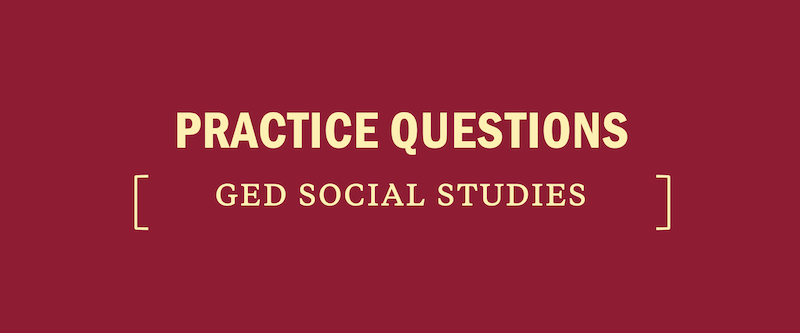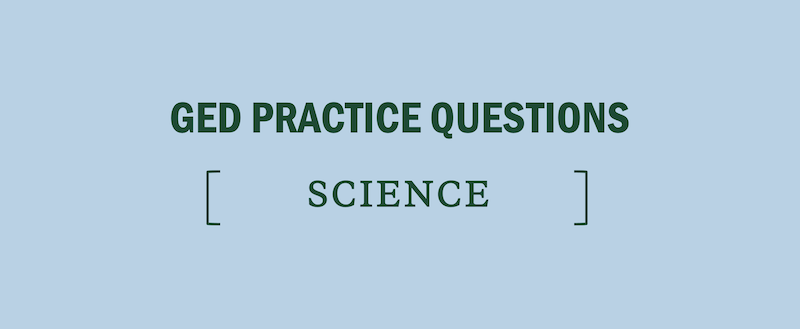What's on the GED: Science
The GED® Science Test evaluates your ability to understand, interpret, and apply science information. You will have 90 minutes to answer 34 questions that are based on reading passages, graphics such as diagrams, tables, graphs, and maps, or a combination of the two. You will need a minimum score of 145 to pass the Science Test, which is one of the four tests you will need to pass in order to earn a high school equivalency diploma.
[ RELATED: GED Science Practice Questions ]
GED Science Content Areas
- Life Science (40%) topics include cell structures and processes, human body systems, health and nutrition, heredity and reproduction, genetics and DNA, evolution and natural selection, and the organization of ecosystems.
- Earth and Space Science (20%) topics include the structure of Earth, plate tectonics, geological cycles and processes, renewable and nonrenewable natural resources, weather and climate, the solar system, and the universe.
- Physical Science (40%) topics include atoms and molecules, properties and states of matter, chemical reactions, energy and work, motion and forces, waves, electricity, and magnetism.
GED Science Practices
In addition to testing your understanding of science passages and graphics, Science Test questions are based on your understanding of skills that are used in scientific study and investigation. These skills are called Science Practices. The science practices include the following:
- Comprehend Scientific Presentations to interpret passages and graphics.
- Use the Scientific Method to design investigations, reason from data, and work with findings.
- Reason with Scientific Information to evaluate conclusions with evidence.
- Apply Concepts and Formulas to express scientific information and apply scientific theories.
- Use Probabilities and Statistics in a science context.
Computer-Based GED Science Test Question Formats
You will work with six question formats on the Science Test. Many of the questions will be in the familiar multiple-choice format, but you will need to be acquainted with the other formats as well.
Math Problems on the GED Science Test
Many science investigations use mathematics. For that reason, there will be math questions on the GED® Science Test.
Although you do not have to use a calculator, you may use either a handheld version or an on-screen version of the TI-30XS MultiView™ calculator on the Science Test. Some problems will say: You MAY use your calculator. When you see that language, the calculator icon appears at the top of the screen. If you cannot remember how to use the calculator, you can open the online Calculator Reference Sheet.
You can click the links to open, move, and close both the online Texas Instruments TI-30XS MultiView™ calculator and the Calculator Reference Sheet. You will want to move them on the computer screen so that they don’t block the problem. Also remember that you will have an off-line wipe-off board that you can use as scratch paper.
Short-Answer Questions on the GED Science Test
Scientists and science students communicate about their work in writing. To reflect that, the GED® Science Test contains two Short-Answer items. The Short-Answer items are based on one passage, two passages, a graphic, or a combination. You will compose your answer in a text box. Read the prompt carefully and use the online highlighter to target specific facts and information that you will use in your response. Because this is a Short-Answer response, it is expected to be about one or two paragraphs long, with complete sentences and well-developed ideas.
An effective response must answer the questions and use specific information from the source materials. It should not be based on your opinions or personal experiences. Since the Short-Answer responses are worth up to 3 points each, take time to understand the question, plan your response, and choose several facts from the information to back up your position.
As with other writing tasks on the GED® Test, you have word processing tools that you can click on at the top of the toolbox that will allow you to do the following:
- Cut (remove extraneous ideas or correct mistakes)
- Copy and Paste (move words and ideas to improve your writing)
- Undo or Redo (use if your change your mind or want to restore)
[ WHAT’S ON THE GED: Social Studies • Language Arts • Mathematics ]







